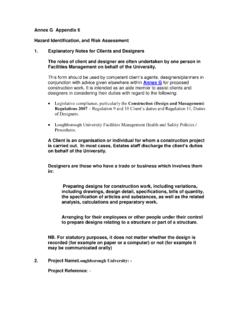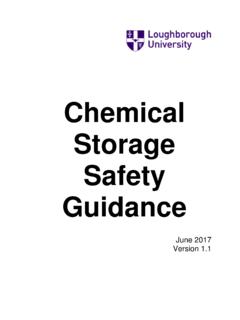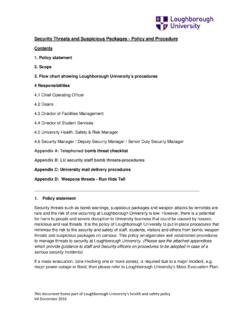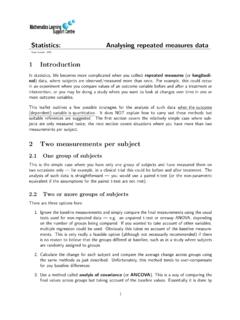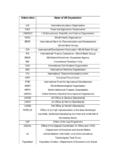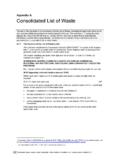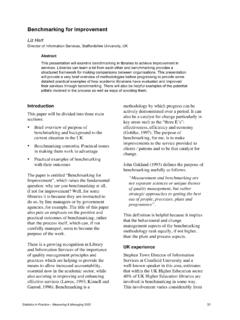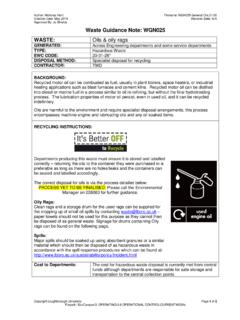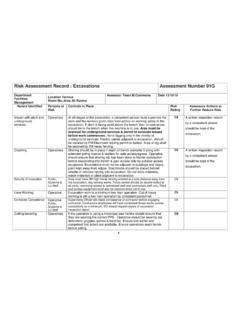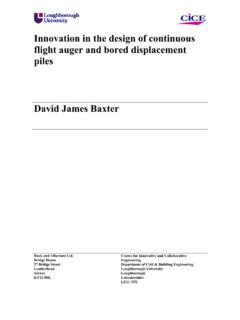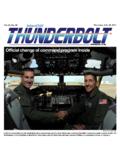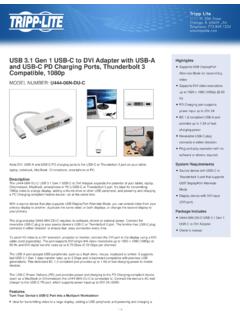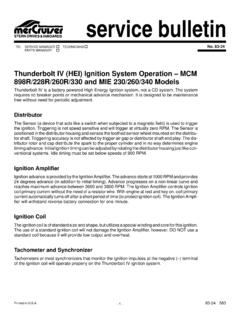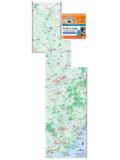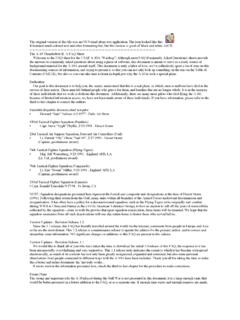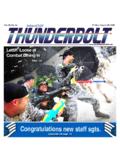Transcription of A-10 Thunderbolt II (Warthog) SYSTEMS …
1 A- 10 thunderbolt ii (Warthog) SYSTEMS engineering CASE STUDY David R. Jacques, PhD, LtCol USAF (Ret) Dennis D. Strouble, PhD Air Force Center for SYSTEMS engineering (AFIT/SY) Air Force Institute of Technology 2950 Hobson Way, Wright-Patterson AFB OH 45433-7765 Report Documentation PageForm ApprovedOMB No. 0704-0188 Public reporting burden for the collection of information is estimated to average 1 hour per response, including the time for reviewing instructions, searching existing data sources, gathering andmaintaining the data needed, and completing and reviewing the collection of information. Send comments regarding this burden estimate or any other aspect of this collection of information,including suggestions for reducing this burden, to Washington Headquarters Services, Directorate for Information Operations and Reports, 1215 Jefferson Davis Highway, Suite 1204, ArlingtonVA 22202-4302.
2 Respondents should be aware that notwithstanding any other provision of law, no person shall be subject to a penalty for failing to comply with a collection of information if itdoes not display a currently valid OMB control number. 1. REPORT DATE 2010 2. REPORT TYPE 3. DATES COVERED 00-00-2010 to 00-00-2010 4. TITLE AND SUBTITLE A- 10 thunderbolt ii (Warthog) SYSTEMS engineering Case Study 5a. CONTRACT NUMBER 5b. GRANT NUMBER 5c. PROGRAM ELEMENT NUMBER 6. AUTHOR(S) 5d. PROJECT NUMBER 5e. TASK NUMBER 5f. WORK UNIT NUMBER 7. PERFORMING ORGANIZATION NAME(S) AND ADDRESS(ES) Air Force Center for SYSTEMS engineering (AFIT/SY),Air Force Instituteof Technology,2950 Hobson Way,Wright Patterson AFB,OH,45433-7765 8. PERFORMING ORGANIZATIONREPORT NUMBER 9. SPONSORING/MONITORING AGENCY NAME(S) AND ADDRESS(ES) 10. SPONSOR/MONITOR S ACRONYM(S) 11. SPONSOR/MONITOR S REPORT NUMBER(S) 12.
3 DISTRIBUTION/AVAILABILITY STATEMENT Approved for public release; distribution unlimited 13. SUPPLEMENTARY NOTES 14. ABSTRACT 15. SUBJECT TERMS 16. SECURITY CLASSIFICATION OF: 17. LIMITATION OF ABSTRACT Same asReport (SAR) 18. NUMBEROF PAGES 102 19a. NAME OFRESPONSIBLE PERSON a. REPORT unclassified b. ABSTRACT unclassified c. THIS PAGE unclassified Standard Form 298 (Rev. 8-98) Prescribed by ANSI Std Z39-18 iiForeword At the direction of the former Secretary of the Air Force, Dr. James G. Roche, the Air Force Institute of Technology established the Air Force Center for SYSTEMS engineering (AF CSE) at its Wright Patterson AFB campus in 2003. With academic oversight by a subcommittee on SYSTEMS engineering (SE), chaired by then Air Force Chief Scientist Dr. Alex Levis, the AF CSE was tasked to develop case studies of SE implementation during concept definition, acquisition, and sustainment.
4 The committee drafted an initial case outline and learning objectives, and suggested the use of the Friedman-Sage Framework to guide overall analysis. The Department of Defense is exponentially increasing the acquisition of joint complex SYSTEMS that deliver needed capabilities demanded by our warfighter. SYSTEMS engineering is the technical and technical management process that focuses explicitly on delivering and sustaining robust, high-quality, affordable solutions. The Air Force leadership has collectively stated the need to mature a sound SYSTEMS engineering process throughout the Air Force. Gaining an understanding of the past and distilling learning principles that are then shared with others through our formal education and practitioner support are critical to achieving continuous improvement. The AF CSE has published seven case studies thus far including the; C-5A, F-111, Hubble Telescope, Theater Battle Management Core system , B-2, Joint Air-to-Surface Standoff Missile, and Global Positioning system .
5 All case studies are available on the AF CSE website [ ]. These cases support academic instruction on SE within military service academies, civilian and military graduate schools, industry continuing education programs, and those practicing SE in the field. Each of the case studies is comprised of elements of success as well as examples of SE decisions that, in hindsight, were not optimal. Both types of examples are useful for learning. Plans exist for future case studies on the Peacekeeper ICBM and NASA s International Space Station. Along with discovering historical facts we have conducted key interviews with program managers and chief engineers, both within the government and those working for the various prime and subcontractors. From this information we have concluded that the discipline needed to implement SE and the political and acquisition environment surrounding programs continue to challenge our ability to provide balanced technical solutions.
6 We look forward to your comments on this A-10 Warthog case study and our other AF CSE published studies. GEORGE E. MOONEY, SES Director, Air Force Center for SYSTEMS engineering Air Force Institute of Technology The views expressed in this Case Study are those of the author(s) and do not reflect the official policy or position of the United States Air Force, the Department of Defense, or the United States Government iiiTABLE OF CONTENTS FOREWORD .. ii 1 SYSTEMS engineering PRINCIPLES .. 1 GENERAL SYSTEMS engineering PROCESS .. 1 DOD DIRECTIVE 5000 DOCUMENTS .. 3 EVOLVING SYSTEMS engineering PROCESS .. 4 CASE STUDIES .. 4 FRAMEWORK FOR ANALYSIS .. 6 2 A-10 system DESCRIPTION .. 8 CHARACTERISTICS .. 8 OPERATIONAL DEPLOYMENTS .. 1 2 3 THE A-10 STORY .. 13 ORIGINS OF THE REQUIREMENTS FOR A CLOSE AIR SUPPORT AIRCRAFT.
7 1 3 Early Doctrinal Considerations .. 13 Lessons from Vietnam .. 13 Army Helicopter Developments and the Johnson-McConnell Agreement .. 14 CONCEPT FORMULATION .. 1 6 The Tactical Force Structure .. 16 Initiation of Concept Formulation .. 17 Early Concept Studies .. 17 The Concept Formulation Package .. 22 Contract Definition .. 28 PROGRAM FORMULATION .. 3 2 Request for Proposals .. 32 Program Initiation for the CAS Gun system .. 33 PARALLEL UNDOCUMENTED DEVELOPMENT THE COMPETITIVE PROTOTYPES .. 3 6 Program Office Activities .. 36 The Prototypes .. 36 Competitive Fly-offs and Shoot-offs .. 38 FULL SCALE DEVELOPMENT .. 4 1 Program Management .. 41 The A-10/A-7D Fly-off .. 41 GAU-8/A Compatibility Testing .. 43 The Armor Piercing Round .. 44 PRODUCTION AND DEPLOYMENT .. 4 5 Production Readiness Issues.
8 45 Hails Report and Recommendations .. 46 DSARC Reviews and Production Decisions .. 48 Variant Considerations and Production End .. 49 RETIREMENT PLANS, OPERATIONS, SUSTAINMENT .. AND LIFE EXTENSION .. 50 The Continuing Debate over the CAS Aircraft .. 50 Desert Storm and Post War Assessments .. 52 Structural Integrity Issues and HOG UP .. 54 A Second Life for a Modern Day Hog .. 60 iv4 SUMMARY .. 62 5 REFERENCES .. 64 APPENDIX A: FRIEDMAN-SAGE MATRIX WITH A-10 LEARNING PRINCIPLES .. A-1 APPENDIX B: AUTHOR BIOGRAPHIES .. B-2 APPENDIX C: TACTICAL AIR CONTROL system CIRCA 1968 .. C-1 APPENDIX D: CONCEPT FORMULATION TRADE SPACE ANALYSIS .. D-1 COMBAT RADIUS AND LOITER TIME CONSIDERATIONS .. D - 1 SURVIVABILITY .. D-3 WEATHER SUITABILITY .. D - 7 COMPARISON OF CANDIDATE AIRCRAFT CHARACTERISTICS AND COST EFFECTIVENESS .. D - 8 APPENDIX E: CONCEPT FORMULATION CANDIDATE CONFIGURATIONS.
9 E-1 APPENDIX F: PROPOSED A-X CONFIGURATIONS .. F-1 APPENDIX G: AIR FORCE FACT SHEET .. G-1 vLIST OF FIGURES Figure 1. The SYSTEMS engineering Process as Presented by DAU .. 2 Figure 2. "Hogs" in Flight .. 7 Figure 3. External View Drawings of the A-10 Aircraft .. 8 Figure 4. A-10 Inboard Profile .. 8 Figure 5. The Teeth of the Hog .. 12 Figure 6. Vietnam era CAS Aircraft: The A-1E Skyraider (L) and A-37A Dragonfly (R) .. 14 Figure 7. Army s AH-56 Cheyenne .. 15 Figure 8. Early Competitors for the CAS Mission - The F-5 (L) and the A-7D (R) .. 17 Figure 9. Coordination for Pre-Planned CAS 23 Figure 10. Close Air Support Mission Sequence .. 24 Figure 11. Sortie Rates for Aircraft in SEA .. 25 Figure 12. The GAU-8/A Gun system .. 35 Figure 13. The YA-9A Prototype .. 37 Figure 14. The YA-10A Prototype .. 38 Figure 15. YA-9A Flight Test .. 38 Figure 16. The YA-10A on Landing.
10 39 Figure 17. Pre-production and Prototype A-10s .. 43 Figure 18. A-10A Firing the GAU-8/A .. 45 Figure 19. A-10 Fuselage and Wing Production .. 47 Figure 20. Flight Testing the YA-10B .. 50 Figure 21. One of the Six A-10s Lost in Desert Storm.. 53 Figure 22. Repaired Aircraft 80-186 .. 54 Figure 23. FSMP Establishes Required Maintenance Actions .. 57 Figure 24. WS 23 - DTA versus ACI Findings .. 57 Figure 25. Comparison of 1999 and 2003 HOG UP Program .. 59 Figure 26. A Newly Modified A-10C .. 61 Figure C-2. The Tactical Air Control system (circa 1968) .. C-1 Figure D-1. Radius Req d for 90-Percent Geo-Area Coverage from Available Runways .. D-1 Figure D-2. Response Time Versus Mission Radii and Cruise Speed .. D-1 Figure D-3. Impact of Loiter Time and Sortie Rate on Force Requirements .. D-2 Figure D-4. Maintenance Man-Hours per Flying Hour for USAF Fighters.
